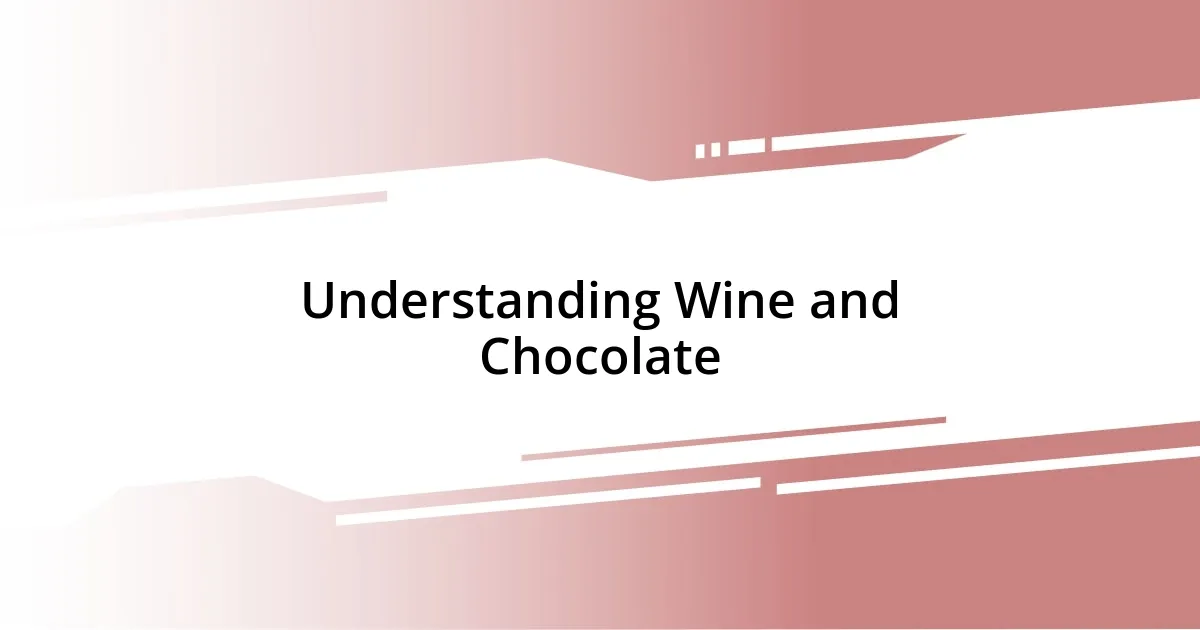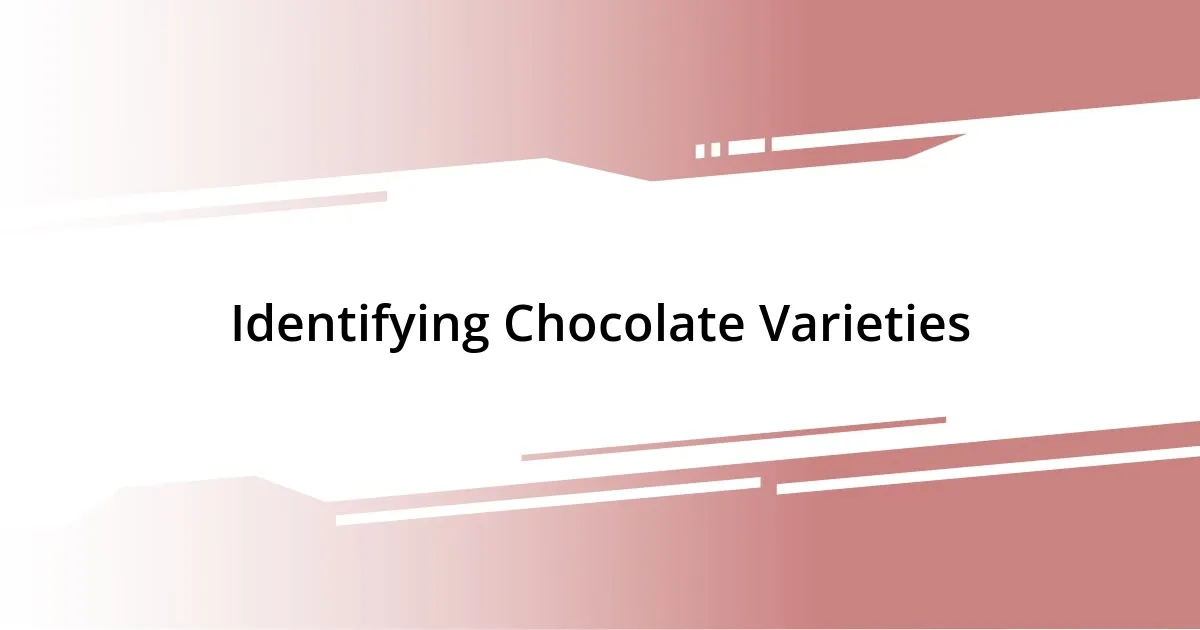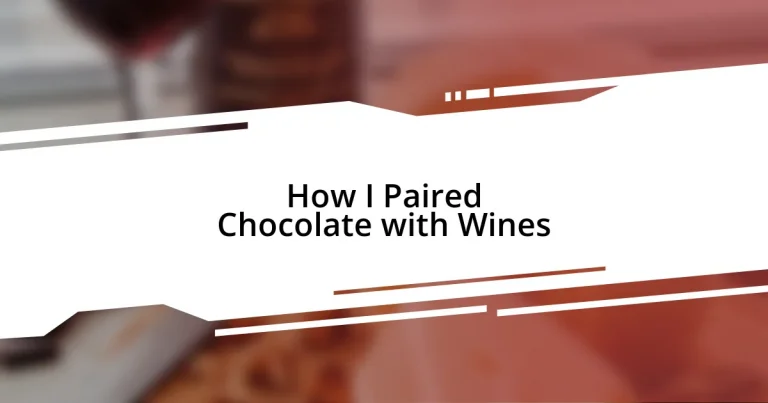Key takeaways:
- Successful wine and chocolate pairings enhance each other’s flavors, with bold wines complementing dark chocolates and lighter wines pairing well with milk chocolates.
- Experimenting with sweetness levels and flavors of both chocolate and wine, such as pairing creamy Chardonnay with milk chocolate or rich dark chocolate with port, creates memorable experiences.
- Serving temperature influences flavor perception; slightly warming chocolates or chilling white wines can enhance the tasting experience.
- Understanding different chocolate varieties, like dark, milk, and artisan chocolates, helps in selecting appropriate wine pairings to create unique tasting adventures.

Understanding Wine and Chocolate
When I first tasted dark chocolate paired with a robust Cabernet Sauvignon, it was like my taste buds had discovered an entirely new language. The deep, rich flavors of the chocolate danced with the wine, creating a symphony of taste that was surprisingly harmonious. Isn’t it amazing how two seemingly different elements can come together so perfectly?
I’ve often wondered why certain wines elevate the experience of chocolate while others fall flat. For instance, lighter wines, such as a Pinot Noir, can complement a delicate milk chocolate, enhancing its creaminess without overpowering it. This delicate balance between the sweetness and acidity in the wine mirrors the smooth textures of the chocolate, making each sip and bite feel like a delightful revelation.
Exploring the interplay of flavors in wine and chocolate has truly been a journey of discovery for me. I remember a memorable evening spent with friends, where we experimented with various pairings. We laughed and debated which combinations worked best, realizing that our preferences were as varied as the wines and chocolates themselves. Isn’t it fascinating how wine can evoke such diverse emotional responses, much like chocolate?

Choosing the Right Wine
Choosing the right wine for your chocolate pairing can feel a bit daunting at first, but it’s all about personal taste. When I began exploring this combination, I found that trying a sweeter dessert wine like a Sauternes with a rich chocolate mousse created a blissful contrast. The honeyed notes of the wine seemed to amplify the chocolate’s decadence, making it unforgettable.
I recall a gathering where we had selected various wines to accompany our chocolate selections. Each choice sparked lively conversation. It became clear that pairing a fruity Zinfandel with dark chocolate infused with raspberry was a hit. The fruitiness of the wine beautifully complemented the tartness of the chocolate, creating a balanced and delightful mouthfeel.
It’s also important to consider the structure of the wine. A full-bodied wine suits bolder chocolates, while lighter wines go beautifully with milder varieties. For example, I once paired a spicy Syrah with chili chocolate, and the warmth of the wine meshed perfectly with the heat of the chocolate, resulting in a truly exciting experience!
| Type of Chocolate | Recommended Wine |
|---|---|
| Dark Chocolate | Cabernet Sauvignon |
| Milk Chocolate | Pinot Noir |
| White Chocolate | Prosecco |
| Chocolate Mousse | Sauternes |
| Chili Chocolate | Syrah |

Identifying Chocolate Varieties
Identifying different chocolate varieties can really enhance your wine pairing experience. It’s fascinating how each type of chocolate brings its own unique flavors and textures to the table. For example, while exploring a chocolate shop, I stumbled upon a bar infused with sea salt, which intrigued me. The salty notes paired with a fruity Merlot created a delightful contrast that was simply unforgettable.
When diving into the world of chocolate, here are some key varieties to consider:
- Dark Chocolate: Bold and intense, great with red wines.
- Milk Chocolate: Creamy and sweet, pairs well with lighter reds or whites.
- White Chocolate: Sweet and buttery, often complemented by sparkling wines.
- Ruby Chocolate: Tangy and berry-like, works beautifully with rosé wines.
- Artisan Chocolates: Unique flavors (like lavender or chili) may require specific wine matching.
Each chocolate variety opens up a world of possibilities, allowing you to create memorable tasting experiences that resonate with your personal preferences.

Pairing Techniques for Success
One effective technique I’ve learned is to think about the flavors in both the chocolate and the wine. For instance, have you ever tried pairing milk chocolate with a creamy Chardonnay? I still remember the first time I experienced this match; the wine’s buttery texture blended beautifully with the sweetness of the chocolate, creating a harmonious balance that felt like a warm embrace.
Another technique is to pay attention to the sweetness level. When I tried a rich, dark chocolate with a port wine, it was like discovering a secret treasure. The sweetness of the port and the bold flavors of the chocolate resulted in a luxurious finish that lingered delightfully on the palate. It made me realize how important it is to match sweetness levels for the best experience.
Finally, don’t shy away from experimenting! I recall a spontaneous tasting I organized, where I brought together some unusual combinations. A smoky chocolate with a peaty Scotch whisky turned out to be unexpectedly fantastic. It taught me that sometimes, stepping out of your comfort zone can lead to the most memorable pairings. So, what will you try next?

Serving Temperature Considerations
When it comes to serving chocolate and wine, temperature plays a crucial role in enhancing flavors. I vividly recall a tasting where I served dark chocolate slightly warmer than room temperature. This minor adjustment allowed the intricate notes to become more pronounced, deepening the overall experience with a robust Cabernet Sauvignon. Have you ever noticed how different temperatures can reveal hidden flavors?
For white wines or desserts like milk or white chocolate, I suggest slightly chilling the wine. I once paired a crisp Sauvignon Blanc with a creamy milk chocolate at a garden party. The coolness of the wine complemented the sweetness of the chocolate, creating a refreshing balance that was perfectly suited for a sunny day. If you’re looking for that delightful contrast, don’t forget to chill!
Lastly, I find that serving chocolate at the right temperature can impact the texture as well. For instance, I remember enjoying a chocolate truffle that was slightly warmer, which made it wonderfully gooey. Paired with a rich, luscious port, the combination created a delightful tension that kept me coming back for more. Have you experimented with this yet? The interplay of warmth and coolness can truly elevate your tasting experience!

Enhancing Flavors in Pairings
When I think about enhancing flavors in pairings, I often recall a memorable evening with spicy chocolate and a bold Zinfandel. The wine’s fruity notes and peppery finish highlighted the heat in the chocolate, creating a dance of flavors that ignited my palate. Have you ever experienced a pairing that surprised you in a similar way? The contrast can really awaken your senses.
Another approach I cherish is the idea of complementary flavors. I vividly remember an intimate dinner where I paired a nutty chocolate with an oaky Chardonnay. The buttery oak notes danced with the chocolate’s richness, producing a delightful synergy. It’s fascinating how flavors can enhance one another, isn’t it? This combination left a lasting impression on me, reminding me of the importance of thoughtful choices.
I am particularly fond of how textures can influence flavor perception in pairings. I once relished a silky milk chocolate alongside a smooth Pinot Noir. It was as if each bite and sip enhanced the other, creating a velvety experience that wrapped around my senses like a cozy blanket. Isn’t it intriguing how a simple textural element can elevate your tasting journey? Every pairing offers an opportunity for exploration, and I can’t help but feel excited about what’s next!














